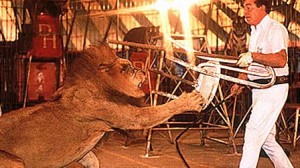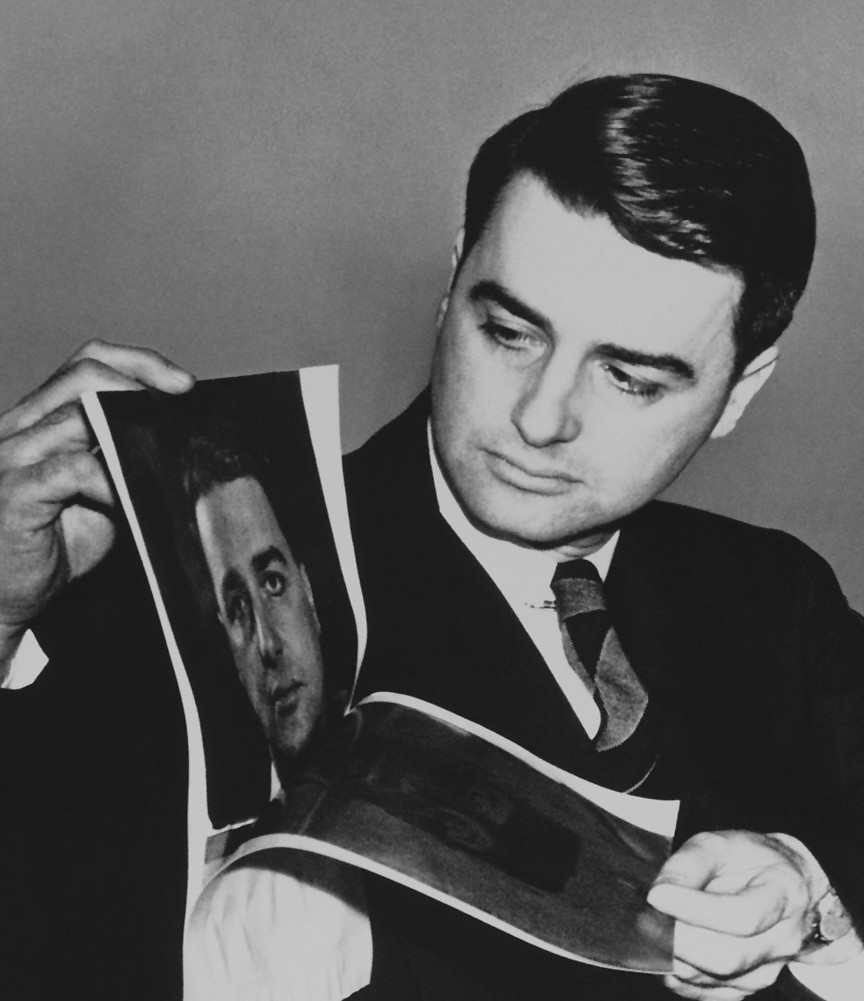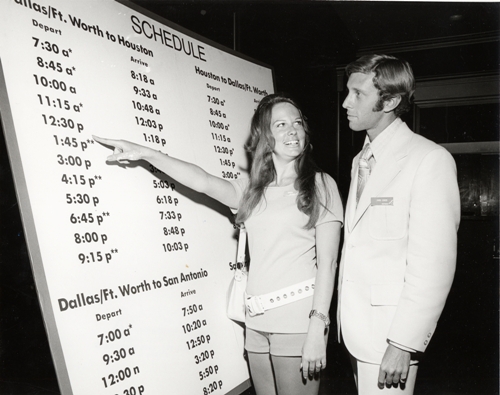Before the Super Bowl was sold as a global event, it was a national one. At Super Bowl III in the Orange Bowl, a trio of Apollo 8 astronauts led the crowd–which included Joe and Ted Kennedy, Bob Hope and Spiro Agnew– in pledging allegiance to the U.S. flag. The Florida A&M University marching band provided the halftime entertainment.
You are currently browsing the archive for the Videos category.
Tags: Bob Hope, Joe Kennedy, Spiro Agnew, Ted Kennedy
IBM celebrates its century mark with a 30-minute film called “They Were There,” which was directed by Errol Morris and scored by Philip Glass. I interviewed Morris once, and I was depressed when he told me how much trouble he has raising money for his amazing documentaries. That’s probably true of every non-fiction filmmaker who isn’t Michael Moore. Well, at least there are coporate gigs to pay the bills.
Forget Purell dispensers, this hospital needs condom machines and gun racks.
Reddit pointed me to this 1987 commercial for what was a really cool and inexpensive black-and-white camcorder for kids, the Fisher-Price PXL 2000. It was a handheld camera that recorded footage using audio cassettes. Intended as a toy, the lo-res pixelvision product was a flop with kids but became a popular, artsy cult item with adults, especially indie filmmakers and graphic designers. It was created by Andrew Bergman, who passed away in 2007 at the young age of 57. An excerpt from a remembrance of the ecelctic inventor from a Stickley Museum newsletter:
“Andy was born in Appleton, Wisconsin, and schooled at Carnegie Mellon and Southern Illinois University, where he taught with prolific innovator Buckminster Fuller. In 1992, he formed the Bergman Design Consortium, a force in the toy design industry. As a self-taught sculptor and furniture designer, Andy spent many summers at Haystack Mountain School of Crafts in Deer Island, Maine. Andy’s zest for life was abundant and was evident in his joyous creations.”
Tags: Andrew Bergman, Buckminster Fuller
In 1972, scientist and Polaroid co-founder Dr. Edwin H. Land released the SX-70 collapsible instant camera, which featured a new type of self-developing film that required nothing of a photographer beyond a point and a click. In the October 27 issue of Life that year, Land unveiled his new invention and opined on the nature of creativity. In his description of the birth of the first Polaroid camera in the 1940s, he offers a pretty great explanation about the creative process in general. An excerpt:
Many people are creative but use their competence in ways so trivial that it takes them nowhere. Their kind of creativity is not cumulative. True creativity is characterized by a succession of acts each depending on the one before and suggesting the one after. This kind of cumulative creativity led to the development of Polaroid photography.
One day when we were vacationing in Santa Fe in 1943 my daughter, Jennifer, who was then 3, asked me why she could not see the picture we had just taken of her. As I walked around that charming town, I undertook the task of solving the puzzle she had set for me.
Within the hour, the camera, the film and the physical chemistry became so clear that with a great sense of excitement I hurried to the place where a friend was staying, to describe to him in detail a dry camera which would give a picture immediately after exposure. In my mind it was so real that I spent several hours on this description.
Four years later we demonstrated the working system to the Optical Society of America. All that we at Polaroid had learned about making polarizers and plastics, and the properties of the viscous liquids, and the preparation of the microscopic crystals smaller than the wavelengths of light was preparation for that day in which I suddenly knew how to make a one-step photographic process. I learned enough about what would work in different fields to be able to design the camera and film in the space of that walk.•
___________________________
In 1970, Edwin H. Land gave a tour of the Polaroid company.
Tags: Edwin H. Land
Footage of the old-school MacLevy Slenderizing Salon health-club chain for women. An excerpt from “Machines Attack the Solid Flesh,” a deeply insulting 1940 Life article about the gyms:
“These pictures were not taken in the torture chamber of a medieval dungeon. They were taken in one of the 200 MacLevy ‘slenderizing salons’ in the U.S. Here massive machines of steel, heavy coil springs and wooden rollers now replace masseuse’s hands in rubbing the fat from lazy female bodies.
To demonstrate these reducing machines Life picked pretty model Pat Ogden, who is placidly letting herself be electrically rolled in the Slendro Massager. With many other New York models, Pat goes to a salon occasionally to keep her figure trim.
Along with Pat, Life sent its fattest researcher to play guinea pig for fat Life readers. She found the machines pleasant and generally painless. The Slendro Massager made her fell ‘like a piece of dough being rolled,’ but like a biscuit she felt no pain. ‘This is like a silent movie where you see yourself being spanked and await with dread the stinging of pain which never arrives,’ she reported.”
“Once we have computer outlets in every home, each of them hooked up to enormous libraries, where anyone can ask any question…everyone will enjoy learning.”
Tags: Isaac Asimov
Architect Gary Chang transforms his micro-apartment in Hong Kong so that it can quickly become 24 different rooms. Meanwhile, I’ve been planning to tighten the towel rack in my bathroom for seven weeks.
Tags: Gary Chang
That’s how you work off the carbs, people. (Thanks Reddit.)
It seems the surest way to announce that your company, products and employees lack genius is to rely heavily on market research and focus groups. What you’re basically saying is that you know you can’t be ahead of the curve so you’d like someone else to help you just keep up. When Steve Jobs was working on the iPad and wanted to rely on touch screens rather than a stylus, his judgement was questioned, particularly because he didn’t do any market research. His response was: “It isn’t the consumers’ job to know what they want,” realizing on his own that moving from mouse to stylus wasn’t a bold step into the future. And I think most great things have been created by one or two people who just knew. There aren’t enough of those people to go around, so we get focus groups instead. (George Lois agrees with me.)
Jobs obviously wasn’t the first one attempt popularizing touch-screen. In the 1983 edition of Computer Chronicles below, Hewlett-Packard reps share their own touch-screen technology. I wonder what market research said about it back then. By the way: The younger host on your right is Gary Kildall.
Tags: Gary KIldall, Steve Jobs
Electric headlights never really caught on.
Septuagenarian Romanian inventor Justin Capra has designed seven unconventional flying machines, including a jetpack.
Tags: Justin Capra
–
Spider-Man would appear to be the biggest dingus of the lot.
This is sad. Let’s hope he gets some help. (Thanks Reddit.)
Vital experiment conducted by Bioastronautics Research.
Made in the wake of the chaos theory entering into public consciousnes, Errol Morris’ unorthodox 1997 documentary focuses on a quartet of men in disparate professions–a wild-animal trainer, a topiary gardener, a mole-rat specialist and a roboticist–trying in their own way to do what the chaos theorists were also attempting to accomplish–find the underlying sense of unity in ostensible disorder.
Gardener George Mendonςa uses his hedge clippers to transform bushes into leafy elephants, giraffes and bears. These painstaking creations take years to grow and can be undone by one severe rainstorm or snowfall. “You’re fighting the elements,” he says, “trying to get them to do what you want them to do. It’s a constant battle.” Also battling is zoologist Raymond A. Mendez, who puzzles over how to create a secure captivity for African mole-rats, whose teeth can chew through concrete. MIT robot scientist Rodney Brooks has to somehow make machines obey his wishes, realizing that every success he enjoys may be helping silicon-based life eventually supplant carbon-based humans.
 While these three men eagerly face their challenges and are largely willing to embrace the future, lion trainer Dave Hoover isn’t quite so cheerful about the the old guard being lost in the shuffle of new ideas: The chaos he faces isn’t only that unpredictable, maned creature in the cage with him, but also a more sophisticated world that isn’t quite so awed by a traveling circus. He pines for his mentor, Clyde Beatty, the legendary animal trainer, and the simpler days when the big top was greeted with a sense of wonder because people weren’t as connected to information and one another. Hoover knows that the accepted order has been undone, disproved and abandoned, to never return. New order, if it exists, must be discovered, and it may never be as grand.•
While these three men eagerly face their challenges and are largely willing to embrace the future, lion trainer Dave Hoover isn’t quite so cheerful about the the old guard being lost in the shuffle of new ideas: The chaos he faces isn’t only that unpredictable, maned creature in the cage with him, but also a more sophisticated world that isn’t quite so awed by a traveling circus. He pines for his mentor, Clyde Beatty, the legendary animal trainer, and the simpler days when the big top was greeted with a sense of wonder because people weren’t as connected to information and one another. Hoover knows that the accepted order has been undone, disproved and abandoned, to never return. New order, if it exists, must be discovered, and it may never be as grand.•
Tags: Dave Hoover, Errol Morris, George Mendonςa, Raymond A Mendez, Rodney Brooks
Bunny rabbits…they hop among us!
Dr. Sidney Cohen is the one dispensing LSD to a patient in this 1950s video that was made at the Los Angeles Veterans Administration Hospital. *Thanks Reddit.) A decade later, in “Psychotherapy with LSD: Pro and Con,” Cohen was still largely singing the praises of acid. An excerpt:
“At a 1965 LSD conference Dr. Sidney Cohen, an American authority on LSD, summed up the claims made for LSD and LSD-like drugs by psychiatrists:
1. They reduce the patient’s defensiveness and allow repressed memories and conflictual material to come forth. The recall of these events is improved and the reaction is intense.
2. The emerging material is better understood because the patient sees the conflict as a visual image or in vivid visual symbols. It is accepted without being overwhelming because the detached state of awareness makes the emerging guilt feelings less devastating.
3. The patient feels closer to the therapist and it is easier for him to express his irrational feelings.
4. Alertness is not impaired and insights are retained after the drug has worn off.
Under skilled treatment procedures, the hallucinogens do seem to produce these effects and one more which is not often mentioned. That is a marked heightening of the patient’s suggestibility. Put in another way, the judgmental attitude of the patient toward the experience itself is diminished. This can be helpful, for insights are accepted without reservations and seem much more valid than under nondrug conditions.”
Tags: Dr. Sidney Cohen
This Southwest Airlines TV commercial was part of the company’s “Remember” campaign from 1972. A note about the early days of the so-called “love airline” and its co-founder Herb Kelleher from CBS News:
“Kelleher is legendary in the airline industry for doing things differently than the competition. Before he found himself Southwest’s pitchman, Kelleher was a lawyer retained by the airline to get it off the ground – a fight that took him all the way to the U.S. Supreme Court. It seemed the last thing Southwest’s competitors wanted to see was a low-cost upstart doing nothing but flying around Texas in and out of Dallas Love Field.
In 1971, ‘the love airline’ took off. At first, Southwest was known for sexy flight attendants in hot pants, which got it the attention it needed.
‘You can have a low-cost carrier and people still don’t fly it because they don’t know about it,’ Kelleher said. ‘And so, the schtick kind of fit in with getting known.'”
Tags: Herb Kelleher
A five-minute clip from a documentary about “visual futurist” artist Syd Mead, who, in addition to creating his own tech-friendly, optimistic work, has been a key force in the art department of many huge sci-fi films, including Blade Runner. In a 2009 interview, Mead addressed the future of our planet:
“Q: What do you think our future will look like? Can we expect something positive or negative?
Syd Mead: The future is what we try to make of it. Obviously we’re going through a earth warming period, which could be caused by our local star, the sun, or other reasons like the accumulation of carbon dioxide. But you have to remember that nature has treated this planet rather harshly several times before, take the asteroid for example that wiped out the dinosaurs.
You have to realize that over 80% of the scientists and engineers that have ever lived are alive right now. So if anything is going to be figured out we’re in a good position to do so now. I like to image a bright future, because that’s healthy. If you really believe that the world is coming to an end then it probably is – you’re helping.”
Tags: Syd Mead
The First Post has an interesting piece about a proposed “straddling bus” in China that will ride above traffic on stilts and be able to transport 1,000 passengers at a time. An excerpt:
“The bizarre-sounding idea is the brainchild of Shenzhen Huashi Future Parking Equipment company, which has developed a ‘3D Express Coach’ that stands four metres high and resembles a moving bridge.
The bus, which is actually a light-rail train, can travel at speeds of up to 60kmph and will be able to carry more than 1,000 passengers. Not only does it reduce congestion, it also cuts down on pollution as it is powered by electricity and solar energy.
And the idea is not as far fetched as it might appear. Work on special tracks for the buses is expected to begin in the Mentougou district in Beijing later this year. But the buses don’t come cheap, each vehicle will cost $75m.”
Lots of gizmos and gadgets.
He sort of sucks. (Thanks Reddit.)
The way medicine used to be practiced before Obamacare ruined everything.
Robot actors on stage and in guerrilla performances. The big advantage is that they use slightly less cocaine than human actors. (Thanks Reddit.)



